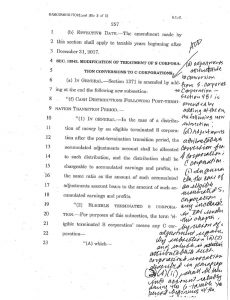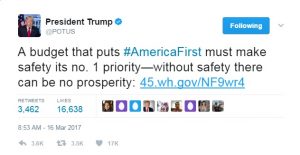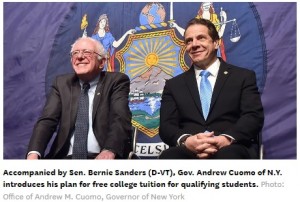Last spring, I wrote about Senator Elizabeth Warren’s college financing proposal for the San Francisco Chronicle. This week, I analyzed for The Conversation former Vice President Joe Biden’s recent proposal to double the maximum Pell Grant as a way of increasing college affordability. The two have taken very different approaches, and assuming they both stay in the race as viable candidates for the Democratic nomination, it will be interesting to see the attention each proposal receives.
Financial Aid
It’s U.S. News rankings time again
U.S. News & Wo rld Report released its annual compendium of rankings of undergraduate colleges and universities across the nation last week. This is usually an eagerly-awaited event at many institutions around the country, and one with which most of us in leadership positions have a love-hate relationship. On the one hand, we all decry how the process attempts to reduce what are in most cases large, complex, and multi-mission institutions into a single number. On the other, we all recognize the attention it generates and the potential impact it can have on the decisions of millions of college-going students.
rld Report released its annual compendium of rankings of undergraduate colleges and universities across the nation last week. This is usually an eagerly-awaited event at many institutions around the country, and one with which most of us in leadership positions have a love-hate relationship. On the one hand, we all decry how the process attempts to reduce what are in most cases large, complex, and multi-mission institutions into a single number. On the other, we all recognize the attention it generates and the potential impact it can have on the decisions of millions of college-going students.
I’ll cut to the chase and the news everyone is most interested in – USF maintained its top 100 position from the prior year, dropping just one spot from tied for #96 last year to tied for #97. But like the proverbial duck on the surface of the water, this small change masks a lot what is happening below the surface.
Senator Warren’s college financing proposals
The 2020 campaign for president is already heating up, and the Democratic field includes almost two dozen candidates. One of them, Senator Elizabeth Warren of Massachusetts, recently unleashed a widely-covered proposal offering “free college” and elimination of student debt for millions of Americans. In an op-ed in the San Francisco Chronicle, I analyzed why Warren’s proposal is not in the best interests of the nation.
The reasons behind tuition increases
Like many universities, during the spring semester USF announces its tuition and fee rates for the following academic year and sends the announcement to continuing students (as well as the parents of undergraduate students). This year, we received a lot of pushback from students because we had not included information about why tuition was going up next year. A grassroots group of students formed and mounted a protest during our Board of Trustees meeting earlier this month. Our student newspaper, The San Francisco Foghorn, published an op-ed and staff editorial complaining about the lack of transparency. Continue reading “The reasons behind tuition increases”
Tax reform that harms graduate students and university employees
The competing House and Senate tax reform bills are large, complex, and often difficult to understand. The Senate bill, for example, is a 479-page document that was passed early in the morning last Saturday and that included last-minute, hand-written passages as shown to the right.  There are numerous parts of each bill that have a large impact on colleges and universities in the country, as well as their students. One estimate calculated after the House bill was passed is that if enacted into law, it would cost students and their families $71 billion over the next ten years. Now that both chambers have passed bills, a conference committee will try to hash out the differences and agree on one bill to be passed by both the House and Senate and sent on to President Trump to be signed into law. Continue reading “Tax reform that harms graduate students and university employees”
There are numerous parts of each bill that have a large impact on colleges and universities in the country, as well as their students. One estimate calculated after the House bill was passed is that if enacted into law, it would cost students and their families $71 billion over the next ten years. Now that both chambers have passed bills, a conference committee will try to hash out the differences and agree on one bill to be passed by both the House and Senate and sent on to President Trump to be signed into law. Continue reading “Tax reform that harms graduate students and university employees”
Why DACA matters to USF and the nation

Earlier this week, under the direction of President Donald Trump, Attorney General Jeff Sessions announced the elimination of the Deferred Action for Childhood Arrivals, or DACA, program. Under his order the approximately 800,000 registered DACA individuals will see their legalized status in this country end in six months, subjecting them to deportation and other administrative actions. The president encouraged Congress to pass legislation that would provide a permanent legalization of the status of DACA registrants, but only if it did so as part of a comprehensive immigration reform plan – something Congress, whether controlled by Democrats or Republicans, has been unable to do for decades.
Why would a high school encourage its students to apply to 100 colleges?
The Chronicle of Higher Education recently published an article titled, “They each applied to more than 100 colleges. That may be the problem” (the article is behind the Chronicle’s paywall; here’s a link to it that will be available for a limited period of time). The article’s lede states:
Anisah Karim was by all measures a good student – she earned high grades, took part in her high school’s selective dual-enrollment program, launched her own culinary nonprofit, and participated in a slew of extracurriculars.
But when her college counselor told her to apply to 100 colleges so she could have a chance at becoming a “million-dollar scholar,” a coveted term her school uses to honor students who receive more than a million dollars in scholarship offers, Ms. Karim said she found herself getting pulled out of class and faced with disciplinary action during her senior year for not meeting application requirements.
Continue reading “Why would a high school encourage its students to apply to 100 colleges?”
President Trump’s first budget guts (sic) funding for higher education
President Donald Trump has submitted his first budget to Congress, an event many have been waiting for anxiously.  Candidate Trump, during the presidential campaign last fall, spoke frequently about reducing the size of the federal government and “draining the swamp” of Washington, so this budget was among his first emphatic statements in support of those pledges.
Candidate Trump, during the presidential campaign last fall, spoke frequently about reducing the size of the federal government and “draining the swamp” of Washington, so this budget was among his first emphatic statements in support of those pledges.
There is a lot to discuss about this FY18 budget, including the fact that virtually every Cabinet and other agency included in the budget – with the exception of Defense, Homeland Security, and Veterans Affairs – is seeing a decrease in funding from FY17 levels ranging from 1 percent (NASA) to 31 percent (EPA). There are my details still missing, however, as this is known as a “skinny budget,” typical of that submitted by first-term presidents who do not have much time to put the budget together. My particular and admittedly selfish interest is how this budget is likely to affect the nation’s roughly 4,600 degree-granting institutions of higher education. Here’s the spoiler, for those who don’t want to bother reading this entire post: The news is not good.
Continue reading “President Trump’s first budget guts (sic) funding for higher education”
New York Governor Cuomo’s proposal for free college – still a bad idea
Earlier this week, New York Governor Andrew Cuomo joined other politicians who have proposed free college programs. As I have pointed out about similar proposals made by President Obama and former presidential candidate Hillary Clinton, there are numerous problems with these programs. In a commentary in The Hechinger Report, I outline why this is still bad public policy.
presidential candidate Hillary Clinton, there are numerous problems with these programs. In a commentary in The Hechinger Report, I outline why this is still bad public policy.
Why any discussions of college affordability need to start with Pell Grants
 There has been a good amount of discussion on the presidential campaign trail about the issue of college affordability and student loan debt. I have written in previous blog posts about some of Hillary Clinton’s proposals, as well as those of Martin O’Malley. This week, I wrote a column for the website The Conversation, where I described why any discussion of college affordability needs to start with the role of Pell Grants, the foundation of the federal government’s student aid programs.
There has been a good amount of discussion on the presidential campaign trail about the issue of college affordability and student loan debt. I have written in previous blog posts about some of Hillary Clinton’s proposals, as well as those of Martin O’Malley. This week, I wrote a column for the website The Conversation, where I described why any discussion of college affordability needs to start with the role of Pell Grants, the foundation of the federal government’s student aid programs.